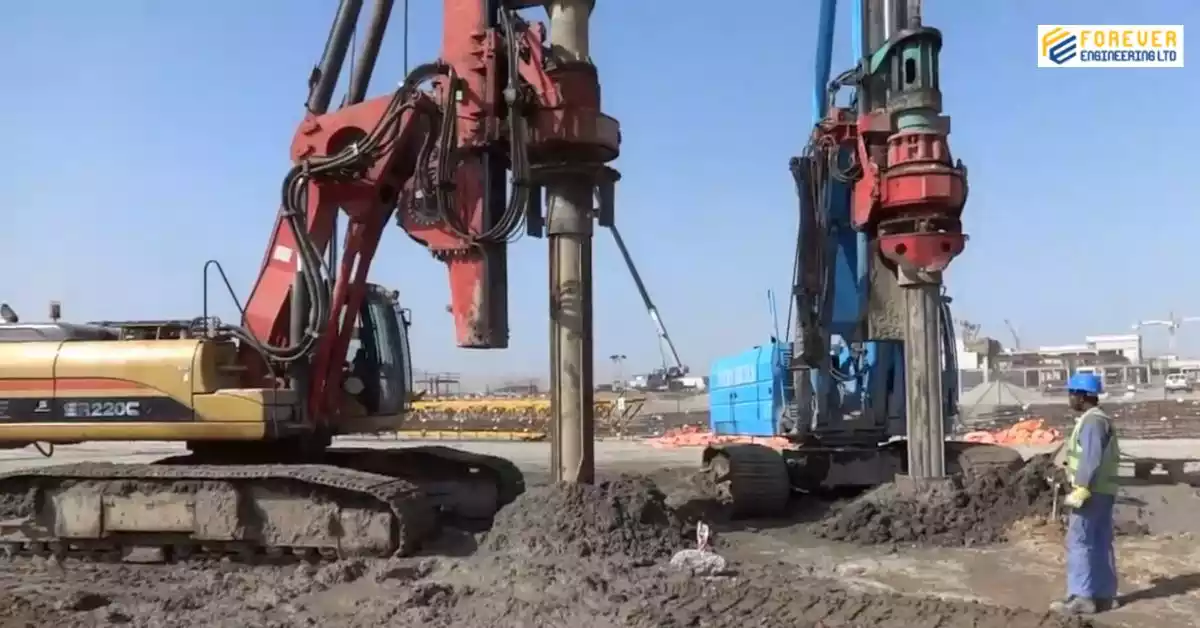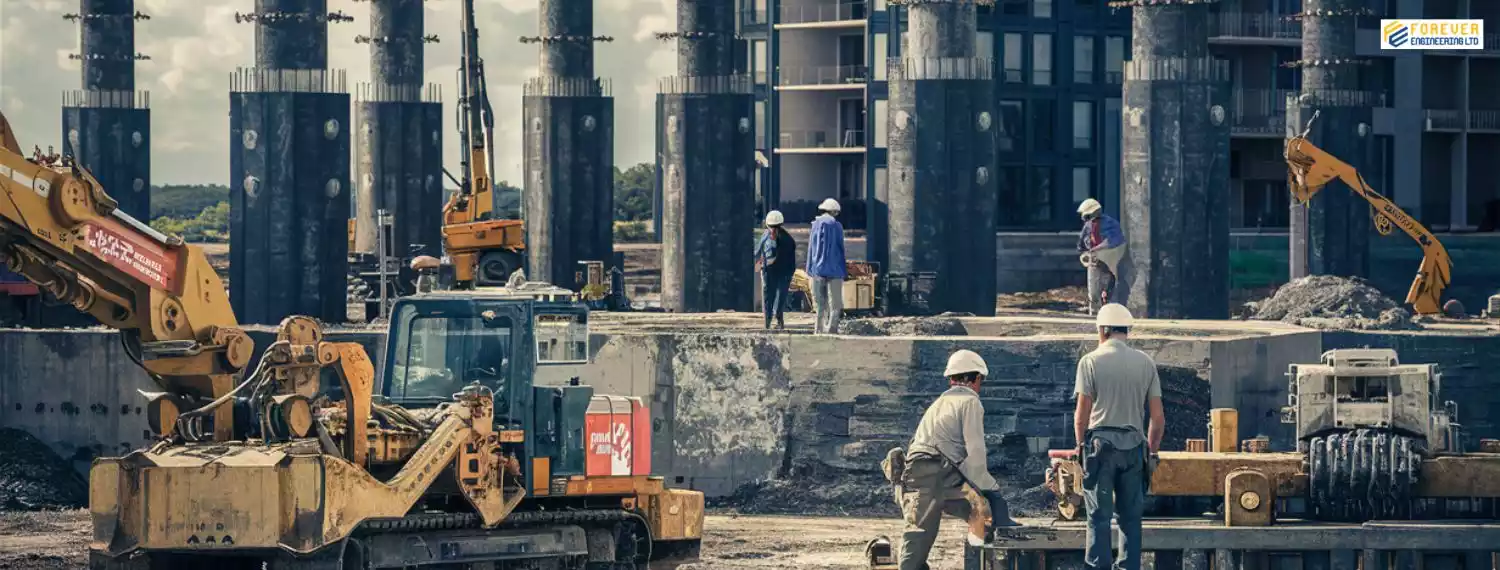Cast-in-situ piles were first invented in the late nineteenth century by A.A. Raymond. It was patented as a Raymond pile system in 1897. This piling method is economical and practical for effectively placing concrete piles in various construction projects. Extensive cast-in-situ pile usage is observed in different soil conditions. In this article, you will learn the versatility and feasibility of cast-in-situ piles.
The Importance of Cast in Situ Piles
Table of Contents
ToggleWhy should you choose cast-in-situ piles instead of other construction methods? You can compare this crucial point that gives you enough reasons to choose it over others.
1. Faster Installation
Cased cast in situ concrete piles involves a streamlined construction process with minimal handling and transportation requirements. We use specialized and modern equipment for quick drilling, soil removal, concrete pouring, and temporary casing extraction.
This decreases the overall installation time. We can also swiftly adjust and place the pile. Our professionals use high, early-strength concrete to complete the project faster.
2. Extensive Range Of Pile Sizes
Cast in situ piles are perfect for a wide range of pile sizes, ranging from 340mm to 630mm in diameter. Before choosing a pile size, we consider important factors, such as soil properties, structural design, desired stability, etc.
We generally employ smaller-diameter piles for lighter structures, low-rise buildings, or projects with limited space. Mid-range pile sizes are perfect for most construction needs.
3. Significant Load Bearing Capacities
The load-bearing capacity of cast in situ piles is much higher than that of other piling methods. It can be anywhere from a few hundred kilonewtons to several thousand kilonewtons per pile.
This will vary based on the diameter, length, design, and soil conditions. Our expert professionals will investigate and analyze the situation to determine the optimal load-bearing capacity for the particular project.
4. Environmental Benefits
Different deep foundations, such as driven piles and drilled shafts, are available for construction projects. However, they cause significant noise, vibration, and disturbance to surrounding areas during installation.
In contrast, cast-in-situ piles generate minimum noise and vibration. We also use unique cast-in-situ techniques to use recycled concrete mix materials, which helps us reduce our environmental impact.
5. Cost Effective
Deep foundation methods, like micro piles and driven precast piles, are more expensive than cast in situ piles. Of course, the installation cost of cast-in-situ piles is a bit high.
But when you consider its long-lasting durability and reliable foundation support, it is worth the investment. On top of that, you don’t have to go through regular high maintenance costs and other structural problems.
What are The Different Types of Cast in Situ Piles?
There are dozens of types of cast in situ pile methods. But these five are the most widely used.

1. Simplex Pile
This is a basic cast-in pile method, where we drive a hollow cylinder steel pipe into the ground. Then, we place a cast iron under the pipe to remove the soil. Our professionals generally use an auger or drilling rig to create a hole.
The simplex piling method is suitable for both soft and hard soils. We usually recommend this method for building foundations, industrial structures, and infrastructure projects.
2. Franki Pile
This method uses a drop weight and temporary steel casing to drive expanded base cast-in-situ concrete piles. It is practically suitable for weak soils and situations requiring high bearing capacity.
Once the base is formed, it will look like a mushroom that can withstand high load-bearing capacity. We will form a compacted soil plug at the last section to ensure extra stability.
3. Vibro Pile
Our professionals utilize a vibrating casing or pile to densify the surrounding soil and create vibro piles while adding concrete simultaneously. We usually recommend using this method for loose or sandy soils.
It enables our professionals to place the concrete securely, even in weak ground conditions. We often use this approach for urban environments with sensitive surroundings. Its reduced vibration will cause minimal vibration.
4. Raymond Pile
We drive a thin sheet of steel tapered shell into the soil, as it ensures easier penetration, unlike straight-sided casing. A steel mandrill is inserted inside to act as a core element and effortlessly remove soil after penetrating the ground.
We generally use this piling method for uneven or unpredictable ground. However, this deep foundation approach is also suitable for challenging soil conditions.
5. Mac Arthur Pedestal Pile
In this piling method, we drive a heavy steel casing along with a core to prevent it from pushing upward. After taking out the core, we will enter a corrugated steel sheet. This sheet type has enhanced load-bearing capacity to resist lateral pressure from soil or water.
Then, we will pour concrete into the shell and withdraw the heavy steel casing. Mac Arthur Pedestal pile is mainly suitable for docks, warehouses, piers, bridges, and retaining walls.
Uses of Cast in Situ Piles in Construction
Cast-in-situ piles are a highly versatile construction method for different structures and soil conditions. The following are the most common cast-in-situ pile usage.

1. Foundations for New Buildings
Whether it is residential or commercial buildings, cast-in-situ piles can help you create a strong foundation for your new buildings. It has a high bearing load capacity to support multi-story buildings or structures with significant weight.
This unique foundation design is also suitable for variable or poor soil conditions like loose sand, filled soil, or uneven bedrock.
2. Bridges and Flyovers
Cast in situ piles can penetrate weak soil layers and reach stable bedrock. This especially comes in handy for vulnerable areas where earthquake and wind forces are common. Its structure will stay stable even under heavy traffic loads.
Plus, there will be minimal vibration during the installation process. It is crucial to avoid damaging existing buildings and infrastructure, especially in urban environments.
3. Power Plants and Industrial Facilities
Power plants and industrial facilities involve working with different heavy machinery and equipment. Driven and bored cast in situ piles can support high vertical and lateral loads. Plus, it enables our engineers to choose the right pile dimensions, reinforcement, and concrete mix based on the soil condition and other factors.
Also, this strong foundation is highly durable even in challenging environmental factors such as corrosion and ground movement.
4. Tunnels and Underground Construction
Cast in situ piles are among the best choices for maintaining the tunnel’s structural integrity or underground construction. Underground soils are soft and unstable.
This construction design allows our engineers to practice a deep anchoring technique to create a strong anchor point for tunnel structures. Its extra support and damping capacity make it a perfect choice for earthquake-prone regions.
Factors Influencing the Choice of Pile Type
Before choosing a particular type cast in situ pile, you must consider some crucial factors.
1. Soil Conditions
Soils come in various types, such as dense sandy soils, soft clays, etc. Their strength level varies from each other. A particular amount of groundwater presence will influence the pile selection. Also, you want to consider their cohesion and frictional properties.
2. Type and Loads
What type of structure do you want to make: building, bridge, dam, retaining walls, or offshore platforms? Consider their load-bearing capacities to ensure adequate support against gravitational forces and wind-induced lateral loads. It will resist deformation and maintain structural integrity.
3. Location
Is your preferred location environmentally sensitive where it could limit noisy or vibration-heavy techniques? Does it have limited space that may restrict pile-driving equipment? It will influence the selection of a particular cast in situ pile type.
Plus, you can’t overlook how close our neighbour structures are. Otherwise, it may damage the nearby foundations.

4. Depth of Load-Bearing Stratum
Not all areas have similar firm soil layer levels. The soil can be anywhere from a few meters to tens of meters below the ground surface. This will significantly influence the selection of a particular type of cast-in-situ pile to ensure a reliable foundation for pile installation.
5. Durability and Longevity
Not all cast in situ pile constructions will have a similar lifespan. If the surrounding environment is harsh, it will affect the structure’s durability. Factors like corrosion, chemicals, etc., will gradually degrade the structure.
Before selecting a particular type cast in situ pile method, consider how long-lasting it will be under specific conditions.
6. Cost
Cast in situ piles are affordable and cost-effective. However, the entire construction project requires considering various factors, such as materials’ cost, pile installation techniques and necessary machinery and equipment.
For instance, driven cast in situ piles are more affordable than precast piles because we use prefabricated concrete sections in driven piles. This allows us to go for mass production. Also, we use expensive equipment, such as drilling rigs in bored piles. But simpler equipment is used in driving piles. This reduces the overall cost.
Frequently Asked Questions (FAQ’s)
Cast in situ piles offer deep foundation support, are adaptable to various soil types, and allow for real-time monitoring of construction quality.
Under favorable conditions, cast-in-situ piles can last decades, often exceeding 100 years, with proper construction and materials.
Yes, cast in situ piles can be effectively used in waterlogged sites with appropriate techniques, such as casing or slurry, to keep the hole open.
Considerations include minimizing vibration and noise during construction and ensuring the concrete mix is environmentally friendly.
Cast-in-situ piles are highly versatile and can be used in a wide range of soil types, from soft clays to hard rock. The specific design and construction method can be adapted to suit the soil conditions of a particular site, making cast-in-situ piles suitable for almost any type of ground.
Driven piles are typically used in softer soils, whereas bored piles are preferred in denser or more challenging soil conditions to minimize disturbance.
Conclusion
Cast in situ piles are an excellent choice for creating heavy structures. This piling method allows you to transfer weight to a stable soil layer and maintain structural integrity. However, you can’t overlook the depth and load level for optimal soil interaction. Before considering a particular type of cast-in-situ pile usage, you also want to consider nearby structures and access for drilling or driving equipment.

